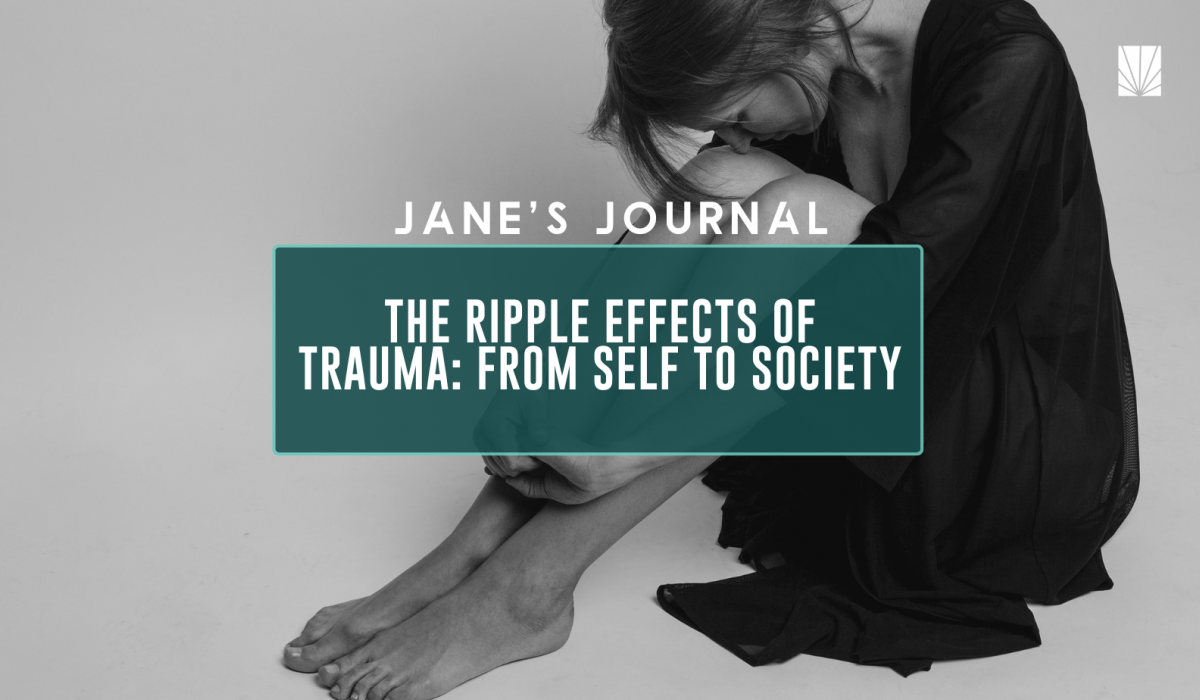
The Ripple Effects of Trauma: From Self to Society
Trauma isn’t something that just happens to us—many times, it becomes woven into the pathways of our mind and structure of our bodies, influencing how we move, react, and feel. Science shows the body holds onto unresolved trauma, storing it in our muscles, tissues, and nervous systems. For many, this manifests as chronic tension, pain, fatigue, depression or anxiety. But beyond the physical symptoms, trauma robs us of our sense of safety and control, disconnecting us from our power and sense of agency. Reclaiming that agency isn’t just a personal healing journey; it’s an act of radical self-liberation. When we work to release trauma from our bodies, we regain the ability to live fully in our truth, to make empowered choices, and to show up authentically in the world.
Healing from trauma isn’t just a personal journey—it’s also a key part of collective liberation. About 70% of adults worldwide experience trauma at some point in their lives, and the impacts go beyond the individual. Communities, especially those facing systemic oppression, carry the weight of collective and generational trauma. That’s why a trauma-informed, personalized approach to healing is vital. When we address trauma on an individual level, we’re not just exploring more pathways to freeing ourselves—we’re building stronger, more resilient communities and ultimately, a better world. By healing ourselves, we create space to show up in activism and social change work from a place of strength and clarity, contributing to a larger movement for justice and liberation.
In this blog, we’ll explore why addressing trauma is essential for both personal and collective liberation, how trauma is stored in the body, and the benefits of using cannabis and other holistic modalities as part of one’s healing journey.
Defining Trauma

Trauma refers to events or experiences that profoundly disrupt an individual’s ability to carry on with day to day activities and cope with normal stressors, often undermining their emotional, psychological, or physiological well-being. Scientifically, trauma is understood as a severe stressor that impacts the nervous system’s functioning and disrupts homeostasis. Trauma can stem from various sources, including acute events like assault or natural disasters, as well as chronic stressors such as ongoing abuse or systemic discrimination.
In clinical terms, trauma is often categorized into two types: Trauma with a capital “T,” which involves life-threatening or highly distressing events that overwhelm the individual’s capacity to cope, and trauma with a lowercase “t,” which includes less severe but still distressing experiences that impact an individual’s functioning. Both types of trauma can trigger maladaptive stress responses and contribute to long-term psychological and physical health issues.
Trauma can also lead to specific disorders such as Post-Traumatic Stress Disorder (PTSD) and Complex PTSD (CPTSD), which are characterized by persistent symptoms. Understanding these distinctions is crucial for developing effective therapeutic interventions, supporting individuals in their recovery process and understanding how trauma impacts us collectively.
The Science of Trauma in the Body

Trauma is stored in our bodies through a complex physiological response involving the nervous system’s survival mechanisms: fight, flight, freeze, and fawn. When trauma occurs—whether emotional, physical, or psychological—the body can become stuck in one of these responses. For example, fawning—where one tries to appease others to avoid conflict—can lead to chronic self-neglect and diminished self-worth. These mechanisms activate the sympathetic nervous system, releasing stress hormones like adrenaline and cortisol. While these chemicals are crucial for defending oneself from immediate threats, their prolonged presence due to unresolved trauma can result in chronic issues such as muscle tension, inflammation, digestive problems, immune suppression and more.
Over time, unprocessed trauma also stiffens the connective tissue surrounding muscles (called fascia) and disrupts proper functioning of the organs, leading to physical tightness, pain, and rigidity. Emotional triggers can activate these stored tensions, causing heightened discomfort in areas like the hips, shoulders, and jaw. In everyday life, this unresolved trauma might show up as persistent back pain that seems to have no obvious cause, sudden emotional outbursts over minor issues, or an overwhelming sense of anxiety that feels disproportionate to the situation at hand. People may also experience difficulty in setting boundaries or making decisions, reflecting the deep-seated impact of trauma on their daily functioning and overall well-being.
How Trauma Shapes Society
Trauma impacts not only individuals but also reverberates throughout communities and society. Research by Dr. Rachel Yehuda shows how trauma can affect gene expression and stress responses in descendants (Yehuda et al., 2014). Historical and systemic traumas, such as those endured by Indigenous peoples and marginalized communities, often result in intergenerational trauma which can negatively influence mental health, socioeconomic conditions, and overall well-being.
Trauma also exacerbates social and economic disparities. Communities affected by systemic violence or discrimination often face barriers to education, healthcare, and economic opportunities, perpetuating cycles of disadvantage. The CDC highlights how adverse childhood experiences (ACEs) lead to long-term health and social challenges, revealing the broader implications of trauma on societal structures (CDC, 2021).
Furthermore, trauma affects community resilience and cohesion, leading to social fragmentation and reduced capacity for collective action. A study by the NIMH emphasizes that addressing trauma at the community level is essential for fostering recovery and rebuilding social capital (NIMH, 2020). By recognizing and addressing these impacts, we can work towards creating more healthy, equitable and resilient communities.
Using Cannabis for Trauma Healing
In recent years, the role Big Pharma plays in designing policy and treatment protocols has come to light. Concurrently, cannabis has gained attention as a powerful more natural medicine for trauma and emotional healing. The endocannabinoid system (ECS), a complex cell-signaling system, plays a critical role in regulating mood, sleep, immune response, and memory. Cannabis, specifically cannabinoids like THC (tetrahydrocannabinol) and CBD (cannabidiol), interact with the ECS to help restore balance to the body and mind.
For trauma survivors, cannabis can be an effective tool for several reasons:
- Reducing Anxiety and Hyperarousal: Trauma often leads to hyperarousal, where the body is in a constant state of fight or flight. This heightened state can make it difficult to relax or feel safe. THC has been shown to reduce anxiety by binding to CB1 receptors in the brain, which are responsible for regulating mood and fear responses. CBD, which is non-psychoactive, can also reduce anxiety by interacting with serotonin receptors.
- Improving Sleep: Trauma survivors often struggle with sleep disturbances like insomnia or nightmares. By calming the nervous system, cannabis, particularly CBD, can help promote deeper, more restful sleep. THC may also shorten the time it takes to fall asleep, making it easier to transition from wakefulness to rest.
- Reducing Pain and Muscle Tension: Cannabis has long been recognized for its anti-inflammatory and pain-relieving properties. For those with trauma stored in the muscles or fascia, the plant can provide relief by decreasing tension and promoting relaxation. Topical cannabis products can also be applied directly to areas of tightness or pain.
- Facilitating Emotional Processing: Some trauma survivors find that cannabis, particularly when combined with therapies like breathwork or somatic experiencing, helps them access suppressed emotions or memories. By altering perceptions and enhancing introspection, THC can create a window of opportunity for emotional healing.
Note: While cannabis can be a powerful ally, it’s important to use it mindfully. Every person’s relationship with cannabis is unique, and dosages should be personalized to avoid adverse reactions. Consulting with a trauma-informed cannabis practitioner or a medical professional is always a wise step before integrating cannabis into a trauma-healing plan.
Other Modalities for Trauma Healing
While cannabis is a promising tool for trauma recovery, there are numerous other holistic modalities that can complement the healing process. Each modality offers a unique approach to addressing trauma stored in the body, allowing individuals to choose what resonates most with them.

- Breathwork: Breathwork is a powerful practice that can help release trauma by connecting individuals to the wisdom of their bodies. Conscious, controlled breathing can downregulate the nervous system and shift it out of a fight-or-flight state. Over time, breathwork practices can help release the tension stored in the body and bring a sense of emotional clarity. Trauma-focused breathwork can be a safe and non-invasive way to reconnect with the body.
- Somatic Experiencing: This body-centered therapy works on the premise that trauma is stored in the body and must be processed physically. Somatic experiencing allows individuals to access and release stored trauma through guided body awareness, gentle movements, and sensory exploration. By focusing on physical sensations rather than the narrative or story of the traumatic event, somatic experiencing can help discharge trapped energy and restore nervous system balance.
- Yoga and Movement: Trauma-informed yoga is designed to support trauma survivors in reconnecting with their bodies in a safe, mindful way. Practices that focus on slow, intentional movements, such as yin or restorative yoga, can help release tension in the fascia and muscles while also calming the mind. Other movement-based modalities, like dance therapy or qigong, can also facilitate emotional release through the body.
- Therapy and Support Groups: Trauma healing often requires professional support. Therapies such as EMDR (Eye Movement Desensitization and Reprocessing), cognitive behavioral therapy (CBT), or psychodynamic therapy can help individuals process trauma and develop coping mechanisms. In addition, support groups offer a sense of community and validation, which can be crucial for feeling seen and understood during the healing journey.
Conclusion: Your Path to Healing

Healing from trauma is not a linear journey, or a one-size-fits-all process. It involves a delicate balance of addressing the body, mind, and spirit, and each individual will have a unique path to reclaiming their full vitality, expression and agency. Whether through cannabis, breathwork, somatic therapies, or a combination of modalities, the key is to find what resonates with you.
If you’re interested in exploring this more, we invite you to join the Jane community – where we offer a safe, supportive space for self-expression, healing and empowerment. Healing is collective as much as it is personal. And that’s why we create spaces, both online and in-person, to do this work – together.
Our upcoming events such as Healing Happy Hour, Survivors Without Access and HEARTs Healing Arts are designed to guide survivors in expressing their truth, reclaiming their agency and finding more peace within. Stay up to date about happenings at TIJP and connect with our network of like-minded individuals on a similar path of healing and growth by coming to an event and following us on Instagram here.
adrenaline, adverse childhood experiences (ACEs), cannabis for healing, cannabis for trauma, chronic pain, collective liberation, community resilience, Complex PTSD (CPTSD), cortisol, emotional triggers, fascia, fawn, fight, flight, freeze, holistic healing, intergenerational trauma, muscle tension, nervous system, psychological impact of trauma, PTSD, social disparities, stress hormones, sympathetic nervous system, systemic oppression, trauma, trauma and society, trauma healing, trauma storage, trauma-informed healing
